SAT For Dummies
Part V
Where the Rubber Meets the Road: Practice Tests
Chapter 28
Practice Exam 5
Gluttons for punishment (big-time overindulgers who actually like difficult experiences) will find a lot to enjoy in this chapter — one complete SAT exam. If you’ve worked through these chapters in order, you already know the drill. If you like to skip around and this is your first practice exam, turn to Chapter 20 for general directions. When you finish with Practice Exam 5, do yourself a favor and take your parrot for a walk, watch a trashy television show, or otherwise amuse yourself. Then open up Chapter 29 to score your exam. Good luck!
Note: The real SAT you take will have ten sections instead of the nine you see here because the College Board throws in an “equating section” that doesn’t count toward your score but allows the testers to evaluate new questions. The SAT doesn’t tell you which section is useless (to you). Because I’m a nice person, I don’t include an equating section in any of the practice tests in this book.
Answer Sheet
For Section 1, use two sheets of loose-leaf or notebook paper to write your essay. For the questions in Sections 2 through 9, use the ovals and grid-ins to record your answers. Begin with Number 1 for each new section. If any sections have fewer than 35 questions, leave the extra spaces blank.
Section 2: Critical Reading

Section 3: Mathematics

Section 4: Critical Reading

Section 5: Mathematics

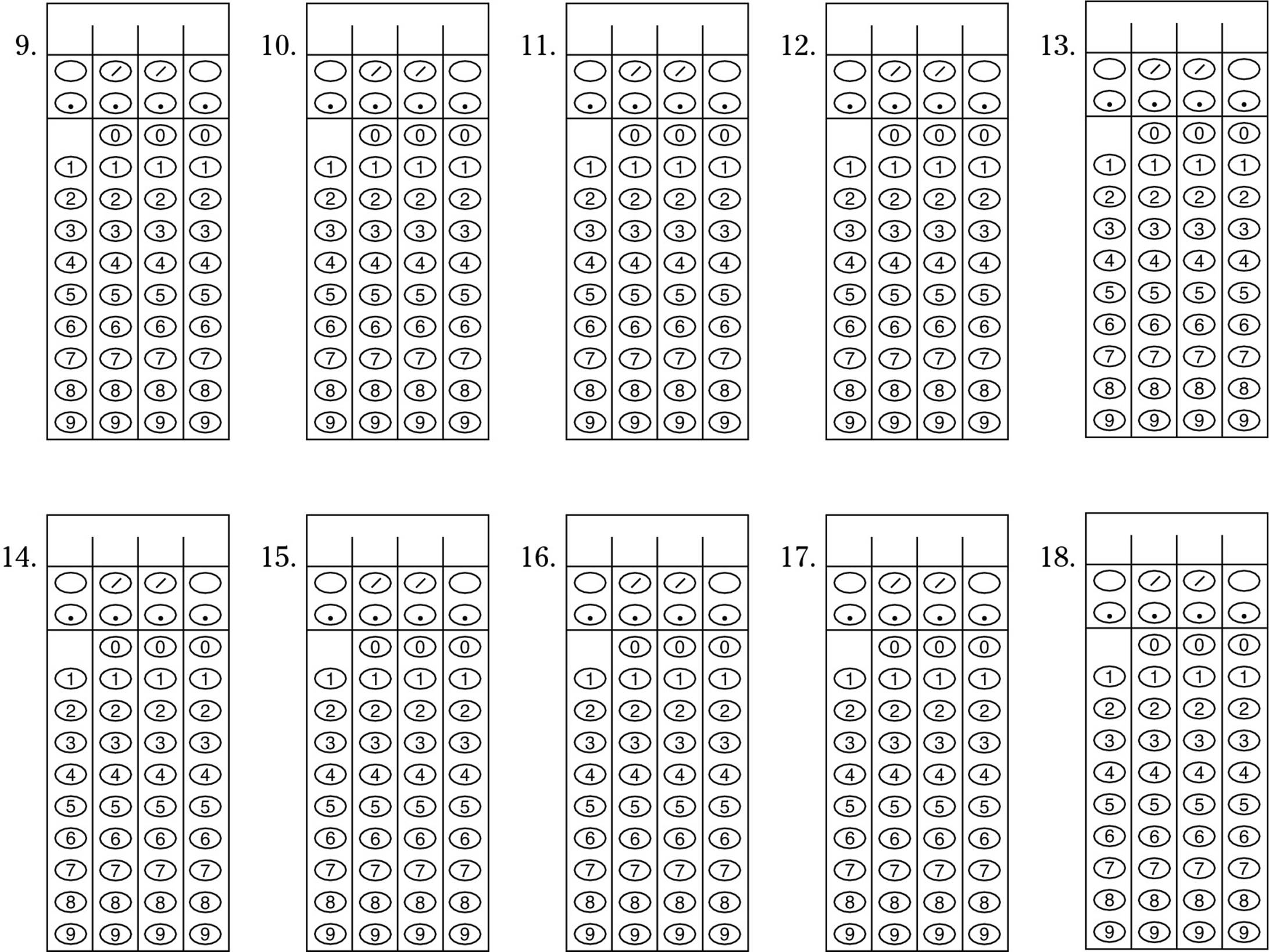
Section 6: Multiple-Choice Writing

Section 7: Critical Reading

Section 8: Mathematics

Section 9: Multiple-Choice Writing

Section I
The Essay
Time: 25 minutes
Directions: In response to the following prompt, write an essay on a separate sheet of paper (the answer sheet). You may use extra space in the question booklet to take notes and to organize your thoughts, but only the answer sheet will be graded.
“The illiterate of the 21st century will not be those who cannot read and write, but those who cannot learn, unlearn, and relearn.” — Alvin Toffler
Must a well-educated person “unlearn” and then “relearn” what he or she has already mastered? Or is knowledge or a skill, once acquired, always an asset? Using examples from literature, history, current events, or your own experience and observations, explain your position on Alvin Toffler’s statement.

Section 2
Critical Reading
Time: 25 minutes for 24 questions
Directions: Choose the best answer to each question. Mark the corresponding oval on the answer sheet.
Directions for Questions 1–5: Select the answer that best fits the meaning of the sentence.
Example: After he had broken the dining room window, Hal’s mother _____ him.
(A) selected
(B) serenaded
(C) fooled
(D) scolded
(E) rewarded
The correct answer is (D).
1. Refusing aid to a beggar does not always indicate a lack of _____, for many people prefer to donate to charitable organizations.
(A) feeling
(B) interest
(C) compassion
(D) planning
(E) individuality
2. In vain, the clerk squinted at his supervisor’s _____ handwriting, unable to _____ it.
(A) sensible . . . evaluate
(B) illegible . . . decipher
(C) confusing . . . alleviate
(D) obtuse . . . normalize
(E) convoluted . . . scrutinize
3. The _____ method of preserving food, though inefficient, was _____.
(A) antiquated . . . effective
(B) modern . . . streamlined
(C) official . . . healthful
(D) banal . . . adamant
(E) compliant . . . rapid
4. The _____ truck driver easily lifted the heavy container.
(A) brawny
(B) scrawny
(C) emaciated
(D) ardent
(E) salubrious
5. How can the principal meet the students’ expectations if they do not _____ what they want?
(A) disperse
(B) articulate
(C) promulgate
(D) exemplify
(E) conceal
Directions for Questions 6–9: Read the following two passages and answer the accompanying questions. Choose the best answer to each question based on what is stated or implied in the passages.
Both passages discuss letters: Passage I concerns letters written by Abigail Alcott, mother of writer Louisa May Alcott. Passage II refers to letters from Abigail Adams to her husband John Adams, the second President of the United States.
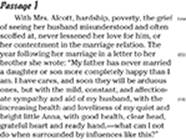
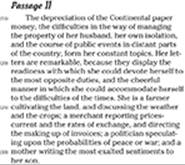
6. In contrast to Passage I, the author of Passage II
(A) is more critical of the letter writer
(B) values cheerfulness
(C) reveals the harsh conditions faced by the letter writer
(D) explains the letter writer’s situation more specifically
(E) disapproves of the letter writer’s actions
7. The “influences” (Line 14) that Abigail Alcott mentions in Passage I are most likely to be
(A) her brother
(B) her father
(C) her husband and daughter
(D) poverty
(E) good health
8. In Passage II, Adams is described as “a farmer” (Line 24), a “merchant” (Line 26), a “politician” (Line 28) and a “mother” (Line 30) because
(A) at various points in her life she filled all these roles
(B) she aspired to each of these careers
(C) she read widely on all these subjects
(D) her husband was not able to fill these roles
(E) her letters included information on all these topics
9. In the context of Line 22 in Passage II, “opposite” may best be defined as
(A) contrary
(B) parallel
(C) inappropriate
(D) varied
(E) clashing
Directions for Questions 10–15: Read the following passage and answer the accompanying questions. Choose the best answer to each question based on what is stated or implied in the passage.
This passage is an excerpt from 200% of Nothing by A. K. Dewdney (Wiley).

10. What is the most likely definition of “innumeracy” (Line 5) in the context of this passage?
(A) an inability to count
(B) difficulty understanding sets and functions
(C) confusion about the complexity of mathematics
(D) a failure to understand mathematical concepts
(E) ignorance of higher-level mathematics
11. The author refers to both the “depth and complexity of mathematics” (Lines 12–13) and “primary concepts” (Line 14) in order to
(A) show that mathematical thinking is innate
(B) explain that mathematics is abstract
(C) reveal the contradictions faced by mathematicians
(D) describe how mathematical study should proceed
(E) advocate for increased study of mathematics
12. Which of the following, if any, are true statements about the identity of the letters “A, B, and C” (Lines 27 and 34–35)?
I. They’re characters in a math word-problem.
II. They have human characteristics.
III. They’re mathematical elements.
(A) I only
(B) II only
(C) III only
(D) all of the above
(E) none of the above
13. With which statement would the author of this passage most likely agree?
(A) Mathematics is accessible to everyone.
(B) Students generally do better than they think they will.
(C) Psychological counseling helps mathematicians.
(D) Many people see mathematics as more complicated than it is.
(E) Anyone who lacks confidence should avoid advanced mathematics courses.
14. In the context of Line 48, the best definition of “alien” is
(A) immigrant
(B) extraterrestrial
(C) unfamiliar
(D) confusing
(E) invasive
15. According to this passage, how should math instruction be organized?
(A) Basic concepts should be presented first.
(B) Students should memorize mathematical rules.
(C) Students should study abstract concepts before attempting complicated problems.
(D) Students should be told to concentrate on the human aspect of math problems.
(E) Teachers should begin with problems based on real situations.
Directions for Questions 16–24: Read the following passage and answer the accompanying questions. Choose the best answer to each question based on what is stated or implied in the passage.
This passage is an excerpt from Walden by Henry David Thoreau.
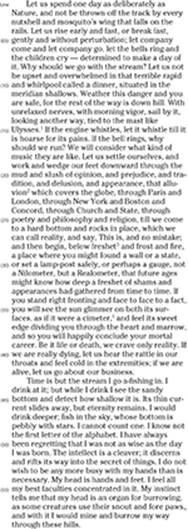
1. Ulysses, a hero of ancient Greek mythology, asked to be tied to the mast of his ship so that he could listen to the enticing songs of sirens without giving in to their enchantment. 2. Flow of water against the shoreline. 3. A stream. 4. A curved knife.
16. The author’s attitude toward Nature may be characterized as
(A) apprehensive
(B) antagonistic
(C) idealistic
(D) uneasy
(E) hostile
17. In the context of Line 1, what is the best definition of “deliberately”?
(A) single-mindedly
(B) respectfully
(C) slowly
(D) rationally
(E) purposefully
18. What do the “nutshell and mosquito’s wing” (Line 3) probably represent?
(A) trivialities
(B) natural enemies
(C) misleading clues
(D) natural barriers
(E) elements of sabotage
19. The whistle of an engine (Line 15) and the ringing of a bell (Line 16) serve as
(A) examples of human achievement
(B) metaphors for an artificial view of time
(C) warnings of danger
(D) aids to those who hear them
(E) temptations to avoid work
20. The author of this passage advocates all of the following EXCEPT
(A) facing death realistically
(B) keeping small events in perspective
(C) living every day to the fullest
(D) avoiding formal education
(E) staying as close to nature as possible
21. What is the “Realometer” (Line 31) supposed to measure?
(A) water level
(B) pretense
(C) time
(D) fire
(E) frost
22. Which statements express the author’s beliefs about time?
I. The time span of each human life is short.
II. Time itself is eternal.
III. There is never enough time to accomplish your goals.
(A) I only
(B) II only
(C) I and II
(D) II and III
(E) all of the above
23. The statement that “my head is hands and feet” (Line 54) means that the author
(A) is clumsy
(B) values manual labor
(C) learns through travel
(D) primarily does intellectual work
(E) is uneducated
24. What is the dominant technique that the author of this passage uses to make his point?
(A) personal stories
(B) examples from history
(C) metaphors and similes
(D) realistic details
(E) denunciation of opposing views

Section 3
Mathematics
Time: 25 minutes for 20 questions
Directions: Choose the best answer to each question. Mark the corresponding oval on the answer sheet.
Notes:
![]() You may use a calculator.
You may use a calculator.
![]() All numbers used in this exam are real numbers.
All numbers used in this exam are real numbers.
![]() All figures lie in a plane.
All figures lie in a plane.
![]() All figures may be assumed to be to scale unless the problem specifically indicates otherwise.
All figures may be assumed to be to scale unless the problem specifically indicates otherwise.

There are 360 degrees of arc in a circle.
There are 180 degrees in a straight line.
There are 180 degrees in the sum of the interior angles of a triangle.
1. Evaluate 3(4 – 2)2 – 2.
(A) –2
(B) 10
(C) 20
(D) 34
(E) 98
2. Which of the following is true for the set of numbers 13, 19, 20, 20, 22, 29, 42, 63?
I. median = mode
II. mean > median
III. mode < mean
(A) I only
(B) II only
(C) I and III
(D) II and III
(E) none of the above
3. Line j intersects line k at a 90° angle. If the
equation of line j is ![]() , which of the
, which of the
following could be the equation of line k?
(A) ![]()
(B) ![]()
(C) ![]()
(D) ![]()
(E) y = 3x + 4
4. If f(x) = x2 + 2x + 1, then f(–2) =
(A) 1
(B) 3
(C) 5
(D) 7
(E) 9
5. If ![]() is 5 less than 7, what is the value of 3x?
is 5 less than 7, what is the value of 3x?
(A) 2
(B) 3
(C) 6
(D) 12
(E) 18
6. In triangle ABC, side AB is 12 units long and side BC is 15 units long. The length of side AC may not equal
(A) 23
(B) 24
(C) 25
(D) 26
(E) 27
7. If |x + 2| = 3, then x is equal to
(A) –5 only
(B) 1 only
(C) 1 and 5
(D) 1 and –5
(E) 5 and –5
8. Twenty-one percent of the students enrolled in Algebra II earned As for the year, 33 percent earned Bs, 27 percent earned Cs, and 76 students earned Ds. If all Algebra II students earned either an A, B, C, or D for the year, how many students earned Bs?
(A) 33
(B) 100
(C) 108
(D) 132
(E) 400
9. A sports team has four times as many girls as boys. Which of the following can be the number of people on the team?
(A) 15
(B) 17
(C) 19
(D) 21
(E) 23
10. If x2 + 2ax + a2 = 16, which of the following could be the value of x + a?
(A) –8
(B) –4
(C) –2
(D) 2
(E) 8
11. Of 150 students in the 11th grade, 82 study Spanish, 75 study French, and 15 study both Spanish and French. How many students study neither language?
(A) 7
(B) 8
(C) 9
(D) 21
(E) 23
12. For all numbers a and b, let a # b be defined as ab. Which of the following is equal to (3 # 2) – (2 # 3)?
I. 4 # 0
II. 1 # 3
III. 2 # 1
(A) I only
(B) II only
(C) III only
(D) I and II
(E) I and III
13. The diagonal of a rectangle is twice as long as its width. If the width of the rectangle is represented as x, what is the area of the rectangle, in terms of x?
(A) ![]()
(B) x2
(C) ![]()
(D) ![]()
(E) 2x2
14. A sequence has 9 as its second term and 17 as its fourth term. If each term is a constant amount greater than the previous term, determine the 13th term of the sequence.
(A) 48
(B) 52
(C) 53
(D) 57
(E) 60
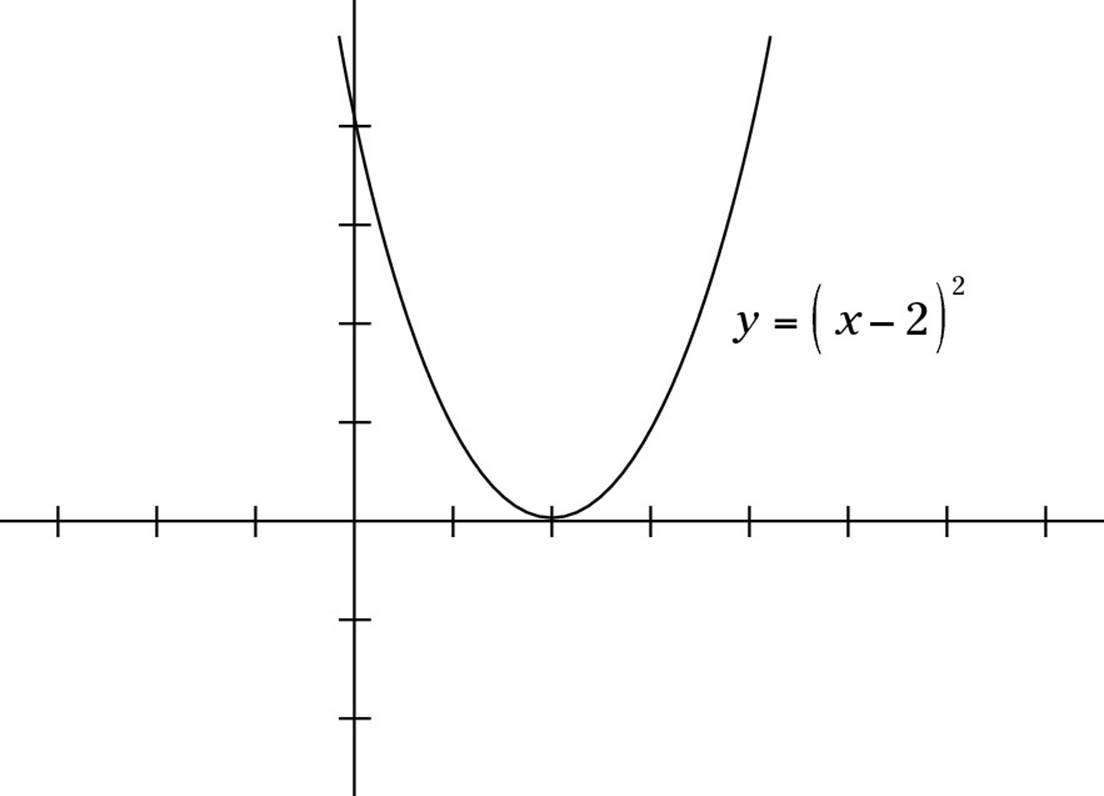
15. The graph shown here is of f(x) = (x – 2)2.
Which of the following choices represents the graph of y = f(x) + 3?
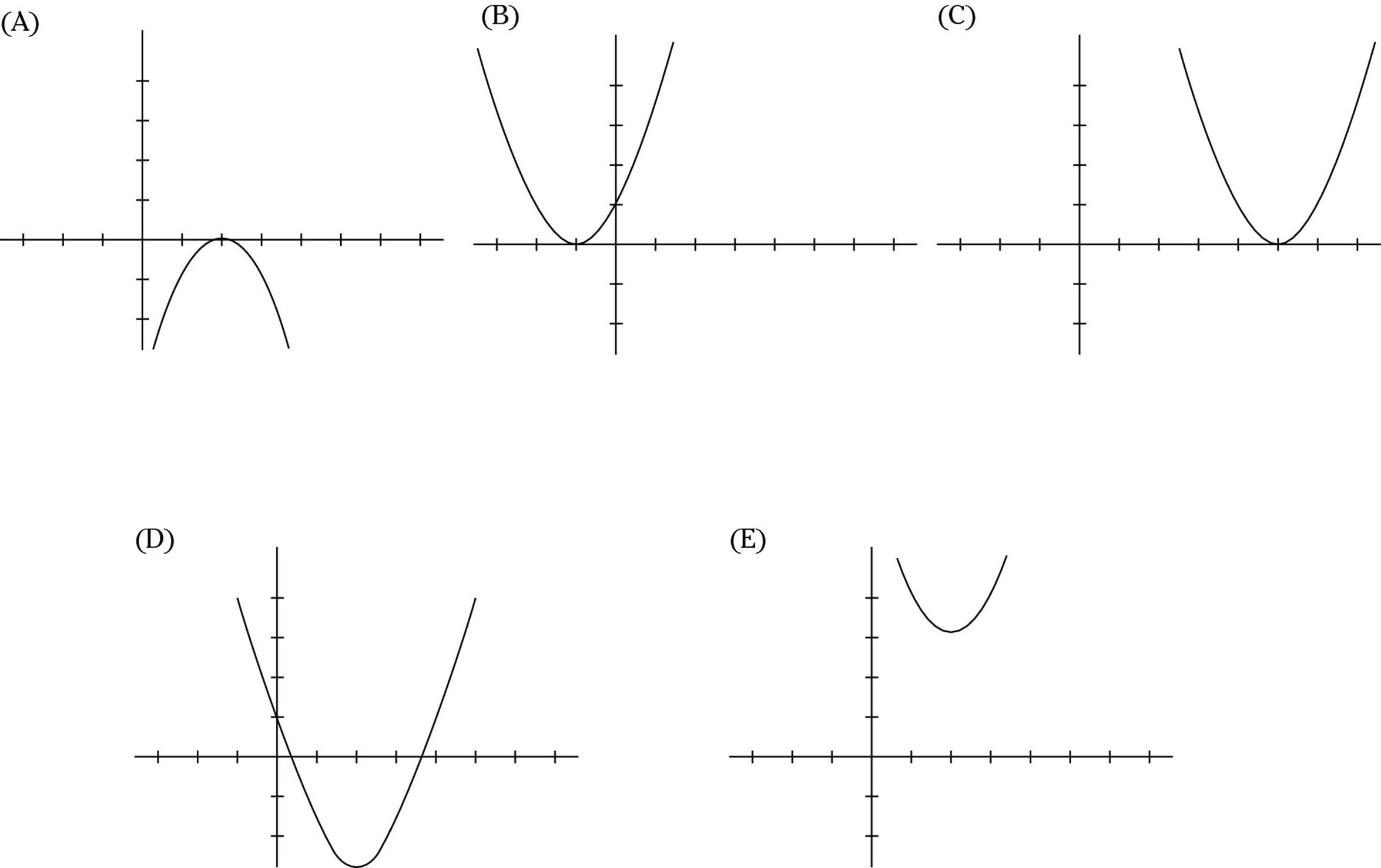
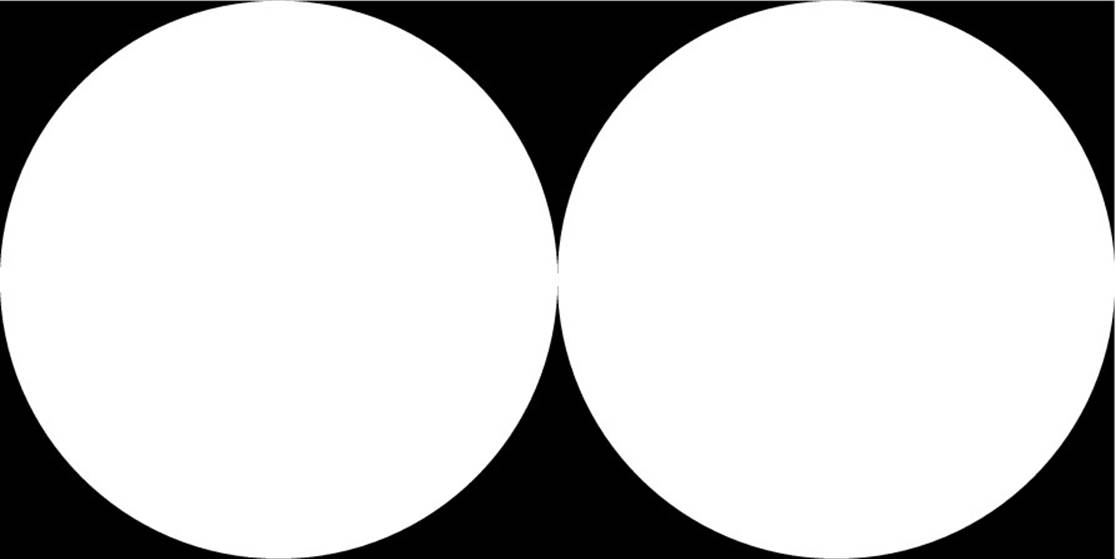
16. The preceding diagram shows a target made up of two circles inscribed in a rectangle. Which answer is closest to the probability that an arrow that hits the target shown lands on the shaded part?
(A) 10%
(B) 20%
(C) 30%
(D) 40%
(E) 50%
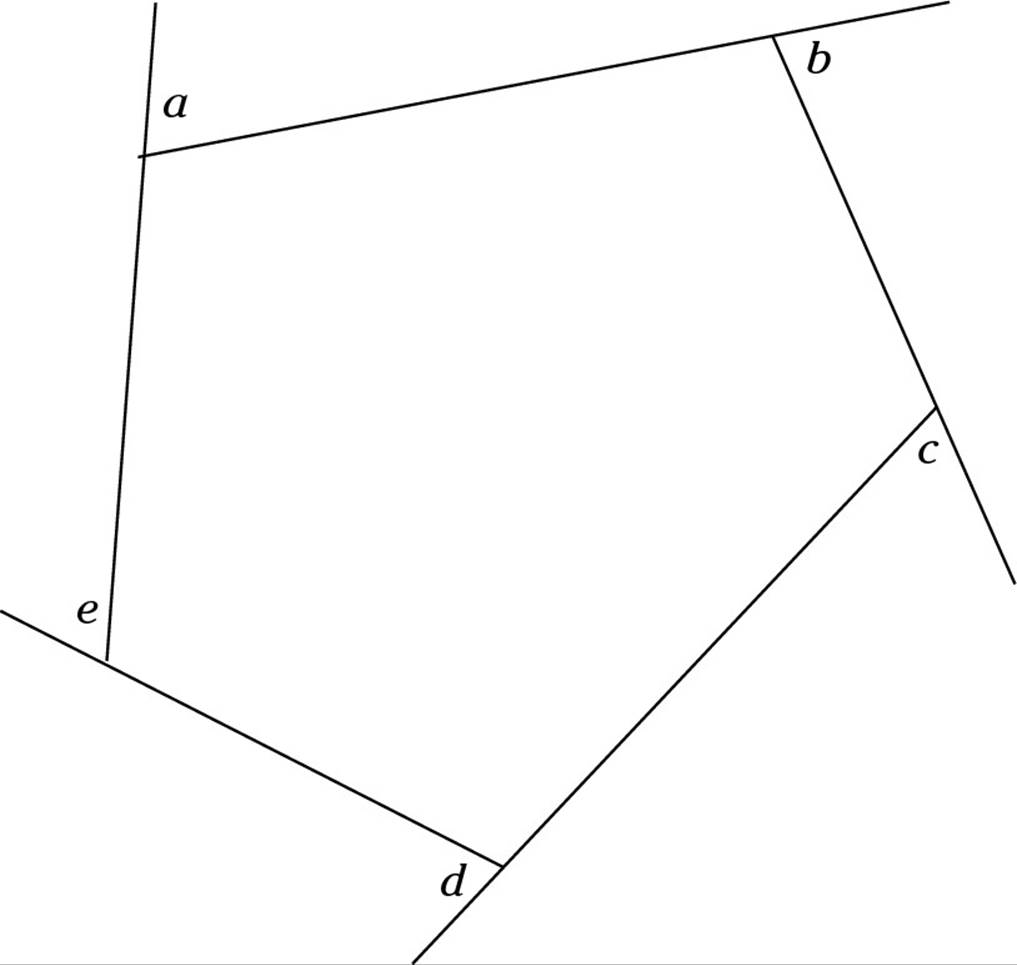
17. What is the sum of the angles marked a, b, c, d, and e in the preceding diagram?
(A) 180°
(B) 270°
(C) 360°
(D) 540°
(E) 720°
18. Jose started a new website and it is quite successful. Every 30 minutes, the number of people viewing the site triples. If 7 people viewed the site at 9 a.m., around what time will there be approximately 2,000 people viewing the site?
(A) 11:00 a.m.
(B) 11:30 a.m.
(C) 12:00 p.m.
(D) 12:30 p.m.
(E) 1:00 p.m.
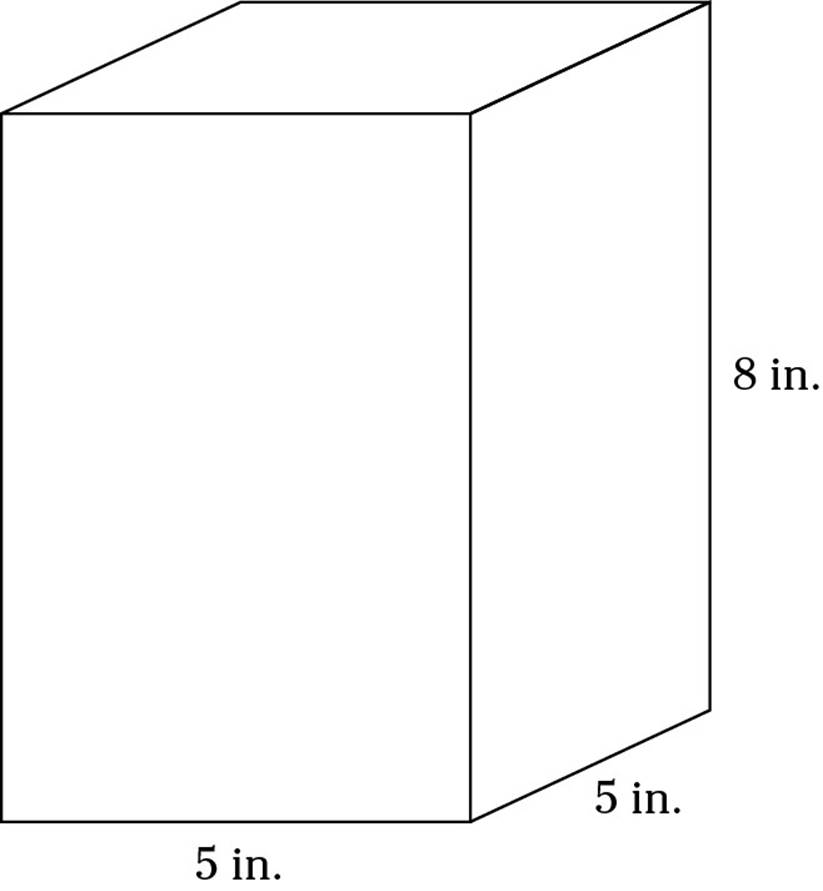
19. This rectangular box, which is empty, has a square base with a length of 5 inches and a height of 8 inches. Beginning at 3 p.m., sand is poured into it at a rate of 5 cubic inches per minute. At what time will the box be exactly three-quarters full?
(A) 3:06 p.m.
(B) 3:25 p.m.
(C) 3:30 p.m.
(D) 3:35 p.m.
(E) 3:42 p.m.
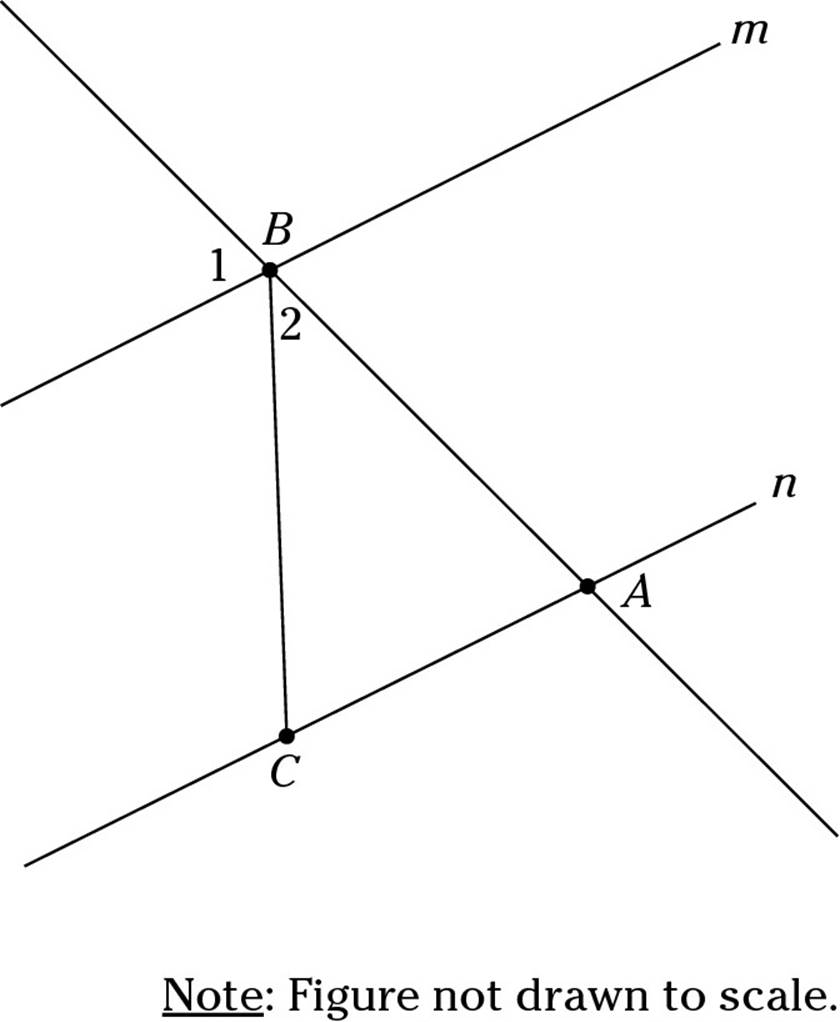
20. In the figure shown, m // n. If the measure of angle 1 = 35° and ![]() , find the measure of angle 2.
, find the measure of angle 2.
(A) 35°
(B) 55°
(C) 70°
(D) 110°
(E) 145°

Section 4
Critical Reading
Time: 25 minutes for 24 questions
Directions: Choose the best answer to each question. Mark the corresponding oval on the answer sheet.
Directions for Questions 1–8: Select the answer that best fits the meaning of the sentence.
Example: After he had broken the dining room window, Hal’s mother _____ him.
(A) selected
(B) serenaded
(C) fooled
(D) scolded
(E) rewarded
The correct answer is Choice (D).
1. After reviewing her business plan, I _____ her proposal and concentrated on those that had a better chance of success.
(A) acclaimed
(B) appreciated
(C) adopted
(D) accepted
(E) discounted
2. Anyone _____ this art form for the first time may be puzzled, but those who have studied abstract painting _____ its complexity.
(A) encountering . . . grasp
(B) practicing . . . lose
(C) collecting . . . overstate
(D) viewing . . . dismiss
(E) creating . . . abolish
3. The elderly man’s _____ financial habits resulted in a comfortable retirement.
(A) spendthrift
(B) prudent
(C) wasteful
(D) dissolute
(E) irresponsible
4. Widespread belief in laws guaranteeing human rights came only after these rights had been _____.
(A) alleviated
(B) violated
(C) elevated
(D) trespassed
(E) confused
5. Instead of reviewing the show, the critic wrote about the actor’s _____, such as eating green candy before each performance and refusing to say any word containing the letter “e.”
(A) demands
(B) weaknesses
(C) talents
(D) habits
(E) quirks
6. By _____ the opposing point of view, the politician showed that he had carefully considered his rival’s ideas.
(A) snubbing
(B) overlooking
(C) ignoring
(D) acknowledging
(E) praising
7. Normally a model of _____, Gary was filled with _____ after the accident.
(A) restraint . . . confusion
(B) joviality . . . elation
(C) equanimity . . . rage
(D) amiability . . . friendliness
(E) courtesy . . . anger
8. Because she had correctly predicted the winner of the election, Sarah gained a reputation for _____.
(A) retrospection
(B) introspection
(C) hindsight
(D) fortune-telling
(E) prescience
Directions for Questions 9–12: Each of the following two passages is followed by two questions. Choose the best answer to each question based on what is stated or implied in the passages.
The first passage is an excerpt from The Contemporary Encyclopedia of Herbs & Spices by Tony Hill (Wiley). The second passage is excerpted from Sacred Fire: The QBR 100 Essential Black Books by QBR: The Black Review, Max Rodriguez, Angeli Rasbury, and Carol Taylor (Wiley).
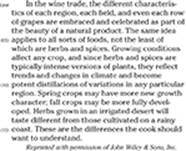
9. According to the author, “the beauty of a natural product” (Line 4) is based on
(A) its purity
(B) the lack of contaminating factors such as pesticides
(C) variations between one batch and another
(D) its ability to grow in many different climates
(E) the way in which people use the product
10. Compared to other crops, herbs and spices are
(A) less variable
(B) more flavorful
(C) grown in fewer areas
(D) less concentrated
(E) more natural
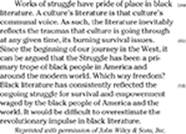
11. With which statement would the author of this passage most likely agree?
(A) Literature can be appreciated only by understanding its historical context.
(B) All literature contains an element of conflict.
(C) Writers cannot express universal truths, only those of a particular culture.
(D) All literature has in it an element of sadness.
(E) Without literature, a community cannot express itself fully.
12. The question, “Which way freedom?” (Line 9), serves to
(A) represent the “Struggle” (Line 7) that black literature addresses
(B) illustrate a universal sentiment
(C) quote from a work of literature
(D) direct the reader’s attention to history
(E) explain why empowerment is necessary
Directions for Questions 13–24: Read the following two passages and answer the accompanying questions. Choose the best answer to each question based on what is stated or implied in the passages.
Passage I is an excerpt from philosopher John Locke’s “Essay Concerning Human Understanding.” Passage II is adapted from Plato’s Republic.
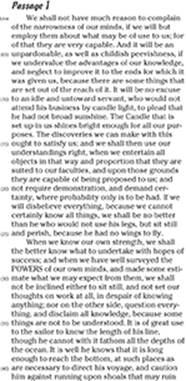
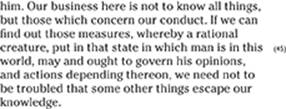
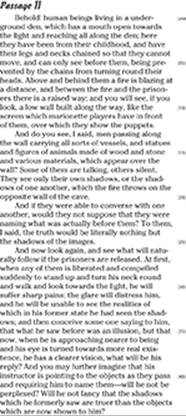
13. Which of the following best expresses the meaning of the statement in Passage I “for of that they are very capable” (Lines 3–4)?
(A) No one truly understands the limitations of the mind.
(B) The power of the mind is unlimited.
(C) Our minds are able to accomplish many useful things.
(D) We should use our minds to express justified complaints.
(E) No complaint about the mind’s power is justified.
14. In Passage I, the story about the servant who wouldn’t work without sunlight is intended to
(A) convince the reader that limitations cannot be overcome
(B) explain that we should learn to work within our limits
(C) compare the weak light of a candle to the strength of sunlight
(D) express a complaint about a servant
(E) illustrate the power of the mind
15. The best definition of “ends” (Line 7) in the context of Passage I is
(A) completions
(B) limits
(C) conclusions
(D) goals
(E) edges
16. The statement that the “Candle that is set up in us shines bright enough for all our purposes” (Lines 12–14) implies that
(A) a small amount of intelligence is all anyone needs
(B) everyone is equally intelligent
(C) people have unequal levels of intelligence
(D) what is beyond human intelligence isn’t necessary
(E) the purpose of the human mind is unknown
17. What may the reader conclude from the story about the sailor and his line in Passage I (Lines 35–42)?
(A) If you know what your brain is capable of, you will use it well.
(B) A line should be as long as possible in order to survey the ocean’s depths.
(C) The brain’s purpose is to foresee danger.
(D) Everyone’s intelligence should be measured by the same standard.
(E) The line and the brain are both limited, so neither is helpful.
18. Unlike Passage I, Passage II
(A) includes the literal truth
(B) employs one comparison only
(C) assumes that human intelligence is unlimited
(D) relies on common experiences to make a point
(E) comes to no conclusion about human intelligence
19. The author of Passage II would most likely agree with which of the following statements?
(A) Trust your instincts.
(B) The truth is always obvious.
(C) Perspective influences what we believe is true.
(D) Life experience has no bearing on our understanding of reality.
(E) The ability to discern the truth is universal.
20. What is the best definition of “conceive” in the context of Line 84 in Passage II?
(A) imagine
(B) create
(C) perceive
(D) hear
(E) pay attention to
21. The “illusion” referred to in Line 85 of Passage II is
(A) objects outside the cave
(B) objects that cast shadows
(C) shadows in the cave
(D) the men in the cave
(E) the instructor
22. Both Passage I and Passage II
(A) urge readers to explore and learn
(B) caution readers to distrust their perceptions
(C) advocate for greater education
(D) see human knowledge as limited
(E) deal with skewed perceptions of reality
23. Which literary technique appears in both passages?
(A) personification
(B) metaphor
(C) concession and reply
(D) understatement
(E) hyperbole
24. How would the question in Lines 88–89 of Passage II, “What will be his reply?” most likely be answered?
(A) You’re wrong.
(B) You’re right.
(C) Both are real.
(D) Neither is real.
(E) Being in the light is always better.

Section 5
Mathematics
Time: 25 minutes for 18 questions
Directions: This section contains two different types of questions. For Questions 1–8, choose the best answer to each question. Mark the corresponding oval on your answer sheet. For Questions 9–18, follow the separate directions provided before those questions.
Notes:
![]() You may use a calculator.
You may use a calculator.
![]() All numbers used in this exam are real numbers.
All numbers used in this exam are real numbers.
![]() All figures lie in a plane.
All figures lie in a plane.
![]() All figures may be assumed to be to scale unless the problem specifically indicates otherwise.
All figures may be assumed to be to scale unless the problem specifically indicates otherwise.

There are 360 degrees of arc in a circle.
There are 180 degrees in a straight line.
There are 180 degrees in the sum of the interior angles of a triangle.
1. If (x + 1)2 = 64, then x could be
(A) –8
(B) –7
(C) 7
(D) 8
(E) 9
2. Set S contains the numbers {1, 2, 3, . . . , 15}. If a number is chosen at random from the set, what is the probability that the number is prime?
(A) 1⁄5
(B) 4⁄15
(C) 1⁄3
(D) 2⁄5
(E) 7⁄15
3. When getting ready in the morning, Marc selects his outfit from among four pairs of pants, six shirts, and two pairs of shoes. If each outfit includes one pair of pants, one shirt, and one pair of shoes, how many different outfits can Marc make?
(A) 12
(B) 20
(C) 27
(D) 48
(E) 54
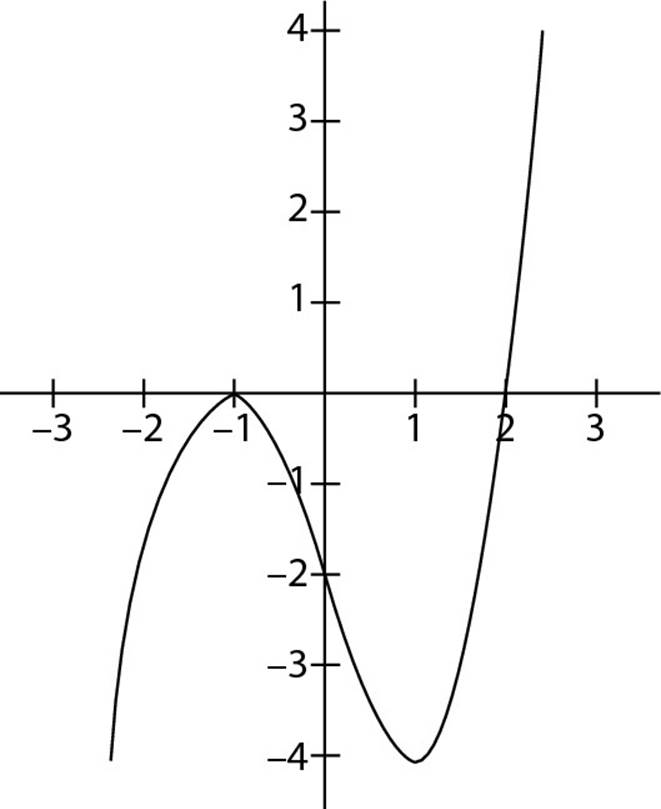
4. The preceding graph represents f(x). How many solutions does the equation f(x) = –1 have?
(A) zero
(B) one
(C) two
(D) three
(E) It cannot be determined from the information given.
5. Which of the following is equal to x · (3x100)3?
(A) 3x104
(B) 27x104
(C) 9x104
(D) 3x301
(E) 27x301
6. A pitcher of lemonade is created using 5 cups of lemon juice, which cost 85 cents per cup, and 7 cups of sugar water, which cost 25 cents per cup. What is the cost, per cup, of the resulting lemonade?
(A) $0.30
(B) $0.50
(C) $0.80
(D) $4.25
(E) $6.00
7. Five students, Johnny, Karen, Lucas, Mario, and Natalia, are comparing the number of articles they have written for the school newspaper. Johnny wrote four articles, the most among the group. Natalia and Mario wrote the same number of articles. Karen wrote one article less than Natalia. Lucas wrote the fewest articles among the boys. What must be true?
(A) Natalia wrote at most three articles.
(B) Karen and Lucas wrote the same number of articles.
(C) Mario wrote four articles.
(D) Lucas wrote more articles than Natalia.
(E) Johnny wrote fewer articles than Mario.
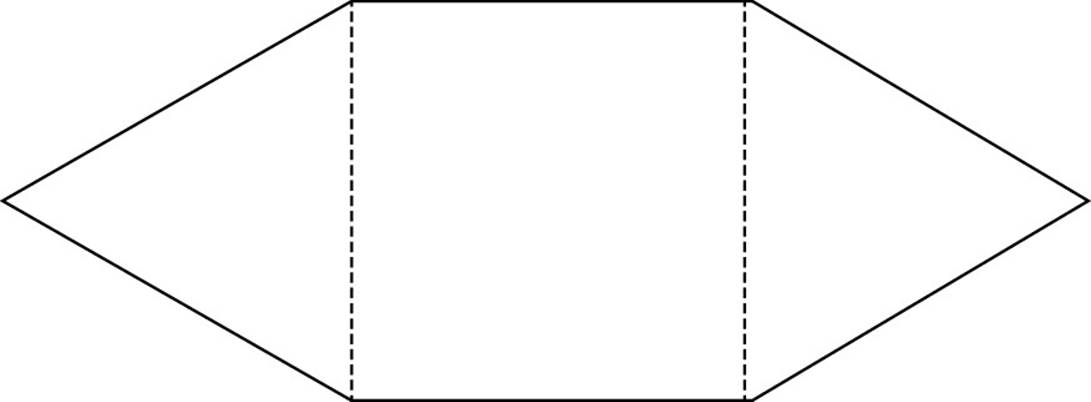
8. The preceding figure is formed by attaching two equilateral triangles to a square with a side length of 4. What is the area of the figure?
(A) 16
(B) 24
(C) ![]()
(D) ![]()
(E) ![]()
Directions for student-produced response Questions 9–18: Solve the problem and then write your answer in the corresponding box on the answer sheet. Mark the ovals corresponding to your answer, as shown in the following example. Note the fraction line and the decimal points.
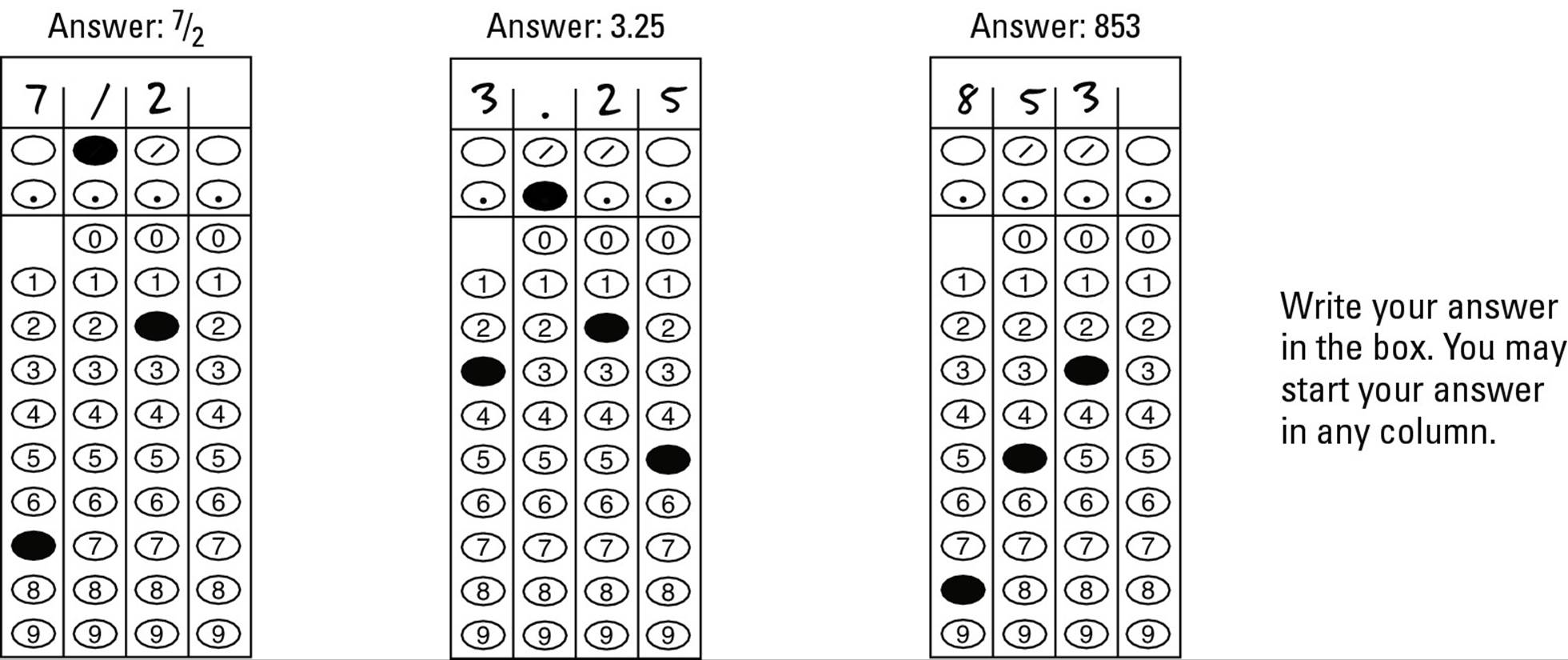
Although you do not have to write the solutions in the boxes, you do have to blacken the corresponding ovals. You should fill in the boxes to avoid confusion. Only the blackened ovals will be scored. The numbers in the boxes will not be read.
There are no negative answers.
Mixed numbers, such as 31⁄2, must be gridded in as decimals (3.5) or as fractions (7⁄2). Do not grid in 31⁄2; it will be read as 31⁄2.
Grid in a decimal as far as possible. Do not round your answer and leave some boxes empty.
A question may have more than one answer. Grid in only one answer.
9. Julie ran the 100-yard dash four times. Her times for the first three dashes were 16 seconds, 18 seconds, and 15 seconds. If her average time on all four dashes was 15.5 seconds, what was her time, in seconds, on the fourth dash?
10. Find a value of x that satisfies x2 = 3x + 10.
11. The line y = mx + b passes through the points (0, 7) and (–2, 3). Determine the value of m + b.
12. The ratio of a rectangle’s length to its width is 5:3. If its area is 60 square inches, find its width, in inches.
13. When a certain number is divided by 5, the remainder is 2. When the number is divided by 7, the remainder is 6. If you know that the number is positive and less than 50, what is one possible value for the number?
14. If ab = 4 and a + b = 5, what is the value of a2 + b2?
15. Hiring a band for a party involves a flat fee and an hourly fee. If it costs $525 to hire a band for 3 hours, and $765 to hire them for 5 hours, what is the flat fee, in dollars?
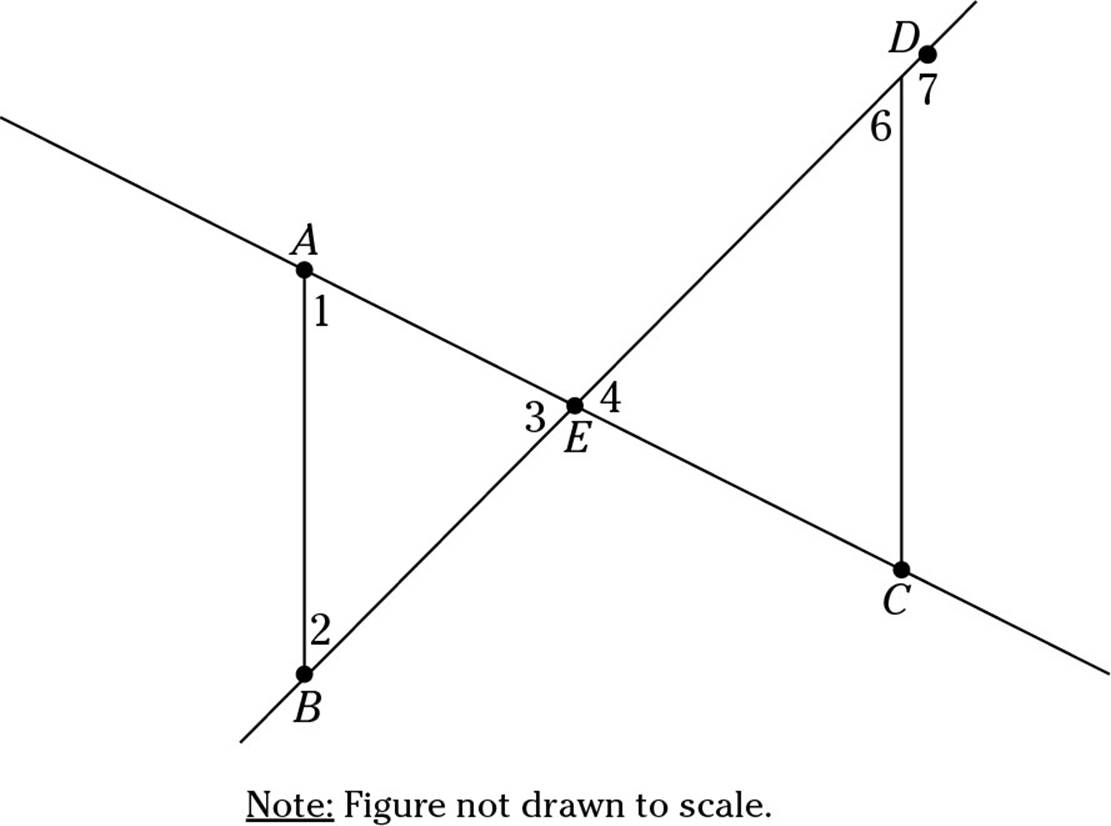
16. Consider the preceding diagram. If ![]() , the measure of angle 7 is 130°, and the measure of angle 1 is 50°, determine the measure, in degrees, of angle 4.
, the measure of angle 7 is 130°, and the measure of angle 1 is 50°, determine the measure, in degrees, of angle 4.
17. For all numbers g and h, let g & h be
defined as  . For what value of h does
. For what value of h does
4 & h = 26?
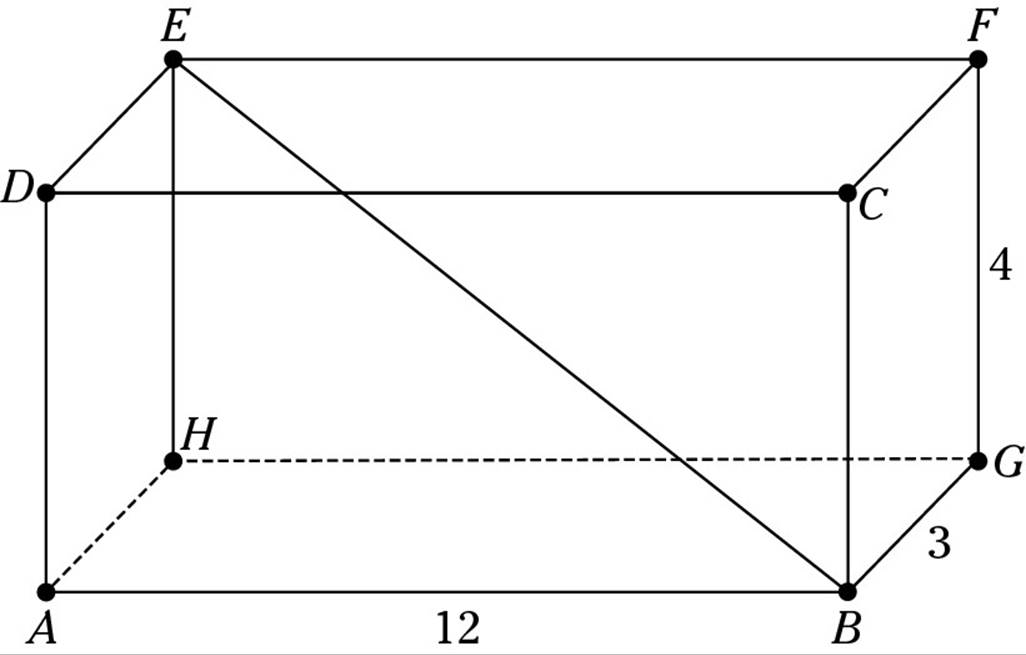
18. Determine the length of segment ![]() .
.

Section 6
Multiple-Choice Writing
Time: 25 minutes for 35 questions
Directions: Choose the best answer to each question. Mark the corresponding oval on the answer sheet.
Directions for Questions 1–11: Each sentence is followed by five choices. Choose the answer that best improves the sentence. If the underlined portion of the sentence is best left alone, choose (A).
Example: Bert and him went to the store to buy boots in preparation for the approaching storm.
(A) Bert and him went
(B) Bert and he went
(C) Bert and he had gone
(D) Bert and him had gone
(E) Bert and himself went
The correct answer is Choice (B).
1. Margaret, who became a teacher shortly after finishing college, was better than any educator at her job.
(A) was better than any educator at her job
(B) did her job better than any educator
(C) did her job best in comparison to any educator
(D) was better than any other educator at her job
(E) had been better than any other educator at her job
2. The real estate broker, correctly predicting a downturn in the market advised his client to sell this year, not next year.
(A) broker, correctly predicting a downturn in the market advised
(B) broker, correctly predicting a downturn in the market, advised
(C) broker, correctly predicting a downturn in the market, he advised
(D) broker, correctly predicting a downturn in the market, had advised
(E) broker, he correctly predicted a downturn in the market and advised
3. Some cultures forbid a man from speaking to their mother-in-law on the theory that such a practice forestalls conflict.
(A) a man from speaking to their mother-in-law
(B) a man that he not speak to their mother-in-law
(C) men not to speak to their mothers-in-law
(D) a man from speaking to his mother-in-law
(E) men, who should not speak to their mothers-in-law,
4. The gardener watered the plant yesterday and added fertilizer, and it helped the plant grow more quickly.
(A) The gardener watered the plant yesterday and added fertilizer, and it helped the plant grow more quickly.
(B) Watering the plant yesterday and adding fertilizer, the plant was helped to grow more quickly by the gardener.
(C) The gardener watered the plant yesterday and added fertilizer, which helped the plant to grow more quickly.
(D) Watering the plant and adding fertilizer yesterday, the gardener helped the plant to grow more quickly.
(E) The watering and fertilizing, by the gardener, yesterday helped the plant grow more quickly.
5. Placing an order for groceries over the Internet is convenient, however, the buyer doesn’t have a chance to see the food and judge its quality firsthand.
(A) is convenient, however, the buyer doesn’t have
(B) is convenient, and however, the buyer doesn’t have
(C) is convenient; however, the buyer doesn’t have
(D) is convenient, but however, the buyer doesn’t have
(E) is convenient, however; the buyer doesn’t have
6. The reason Dansworth was given two additional responsibilities is that his salesmanship is exemplary.
(A) was given two additional responsibilities is that
(B) was given two additional responsibilities is because
(C) has been given two additional responsibilities is because
(D) was given two additional responsibilities are that
(E) was given two additional responsibilities are because
7. Although struggling with the most complicated figure-skating moves and falling twice, the judges awarded Sarah high scores.
(A) Although struggling with the most complicated figure-skating moves and falling twice, the judges awarded
(B) Although she struggled with the most complicated figure-skating moves and fell twice, the judges awarded
(C) Although she was struggling with the most complicated figure-skating moves and having fallen twice, the judges awarded
(D) Although Sarah struggling with the most complicated figure-skating moves and falling twice, the judges awarded
(E) Although struggling with the most complicated figure-skating moves and falling twice, Sarah was awarded by the judges
8. Whether the mayor authorizes the new zoning laws, which promote environmentally friendly practices, or not remains to be seen.
(A) Whether the mayor authorizes the new zoning laws, which promote environmentally friendly practices, or not
(B) Whether the mayor authorizes the new zoning laws, which promote environmentally friendly practices, or whether he does not
(C) If the mayor authorizes the new zoning laws, which promote environmentally friendly practices,
(D) If the mayor authorizes the new zoning laws or not, which promote environmentally friendly practices,
(E) Whether or not the mayor authorizes the new zoning laws, which promote environmentally friendly practices,
9. Given new information, the astronomer revised her theory before submitting her article to that journal.
(A) Given new information, the astronomer revised
(B) Her having been given new information, the astronomer revised
(C) Given new information, the astronomer had revised
(D) Because of the new information that had been given to her, the astronomer revised
(E) With her new information having been given, the astronomer revised
10. The wedding that had been scheduled to take place in August, having been postponed because of the bride’s illness and rescheduled for November.
(A) that had been scheduled to take place in August, having been postponed
(B) , which had been scheduled to take place in August, having been postponed
(C) had been scheduled to take place in August but was postponed
(D) had been scheduled to take place in August it was postponed
(E) that was scheduled to take place in August, it was postponed
11. Strong winds and hail ripped through the area last night, and tree branches were broken off, crushing cars.
(A) ripped through the area last night, and tree branches were broken
(B) ripped through the area last night, and tree branches broke
(C) had ripped through the area last night, and tree branches were broken
(D) had ripped through the area last night, and tree branches broke
(E) ripped through the area last night, and tree branches had broken
Directions for Questions 12–29: In each of the following sentences, identify the underlined portion that contains an error. If the sentence contains no errors, choose (E) for “no error.” Note: No sentence contains more than one error.

The correct answer is Choice (A).
12.

13.

14.

15.
![]()
16.

17.

18.

19.
![]()
20.

21.

22.

23.

24.

25.

26.

27.
![]()
28.

29.

Directions for Questions 30–35: These questions are based on the following essay. Choose the best answer to each question.
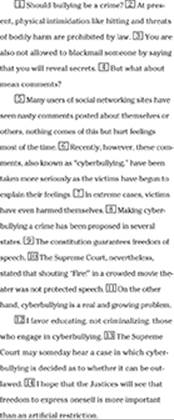
30. What is the best change to Sentence 2?
(A) Delete “like hitting and threats of bodily harm.”
(B) Change “are prohibited” to “is prohibited.”
(C) Move “at present” to the end of the sentence.
(D) Add examples of “bodily harm.”
(E) Place Sentence 2 after Sentence 3.
31. How should Sentence 3 be changed, if at all?
(A) No change.
(B) Insert a comma after “someone.”
(C) Change from second person (you are, you will) to third person (people are, they will).
(D) Insert “their” before “secrets.”
(E) Add examples of secrets that may be used in blackmail.
32. What is the best revision of the underlined portion of Sentence 5, reproduced here:
Many users of social networking sites have seen nasty comments posted about themselves or others, nothing comes of this but hurt feelings most of the time.
(A) No change.
(B) Change the comma after “others” to a semicolon.
(C) End the sentence after “others.” Begin a new sentence with “Nothing comes from these comments but.”
(D) Insert a comma after “this.”
(E) Change “themselves” to “himself or herself.”
33. Which revision, if any, would most improve Paragraph 1?
(A) No change.
(B) Delete Sentence 4.
(C) Move Sentence 12 to Paragraph 1.
(D) Define “cyberbullying” in Paragraph 1 and delete the phrase, “also known as cyberbullying” from Sentence 6.
(E) Explain that bullying may take place in person, not just through electronic media.
34. How may Paragraph 2 be improved?
(A) No change.
(B) Add more statements on the importance of freedom of speech.
(C) Explain both positions, for and against the law, more fully.
(D) Delete Sentence 8.
(E) Move Sentence 8 to Paragraph 1.
35. How should Sentence 13 be revised, if revision is necessary?
(A) No change.
(B) Someday, the Supreme Court may hear a case, and cyberbullying will be outlawed or not.
(C) Someday, the Supreme Court may hear a case that will decide whether cyberbullying may be outlawed.
(D) The Supreme Court, someday, may decide a case that means cyberbullying is outlawed, or it is not.
(E) The Supreme Court may decide a case, and someday cyberbullying will or will not be outlawed.

Section 7
Critical Reading
Time: 20 minutes for 19 questions
Directions: Choose the best answer to each question. Mark the corresponding oval on the answer sheet.
Directions for Questions 1–6: Select the answer that best fits the meaning of the sentence.
Example: After he had broken the dining room window, Hal’s mother _____ him.
(A) selected
(B) serenaded
(C) fooled
(D) scolded
(E) rewarded
The correct answer is Choice (D).
1. The _____ meeting hall provided _____ room for all the delegates.
(A) capacious . . . ample
(B) minuscule . . . sufficient
(C) cramped . . . abundant
(D) choleric . . . excessive
(E) gargantuan . . . ineffective
2. Red silk shades _____ the luxurious furniture of the room.
(A) complimented
(B) complemented
(C) insinuated
(D) belied
(E) resolved
3. _____ is the enemy of productivity.
(A) indolence
(B) ingenuity
(C) resourcefulness
(D) motivation
(E) compensation
4. “I won’t make any _____ comments about my opponent,” declared the politician, as she vowed to run a positive campaign.
(A) laudatory
(B) derogatory
(C) congratulatory
(D) deferential
(E) obsequious
5. The _____ refused to pay for anything beyond the basics, carefully accounting for every dollar.
(A) spendthrift
(B) wastrel
(C) miser
(D) cutpurse
(E) philanthropist
6. Because she was late for school so often, the principal _____ the little girl’s recess time.
(A) abridged
(B) enriched
(C) expanded
(D) curtailed
(E) excerpted
Directions for Questions 7–19: Read the following passage. Then choose the best answer to each question based on what is stated or implied in the passage.
The passage is an excerpt from The Calling of Katie Makanya by Margaret McCord (Wiley), a biography of a young girl growing up in South Africa in the late 19th century.

7. The details included in Paragraph 1 (Lines 1–14) serve to
(A) establish how Katie will face these hardships
(B) explain why Katie is there
(C) reveal Katie’s snobbery
(D) show that Katie doesn’t belong
(E) illustrate the poverty of the neighborhood
8. How may the relationship between Katie and Charlotte be characterized?
(A) mentor to student
(B) affectionate equals
(C) vicious opponents
(D) fractious relatives
(E) jealous peers
9. What is implied by Charlotte’s question (Line 22), “Are you better than Ma?”
(A) Ma is too poor.
(B) Ma complains too much.
(C) Katie complains too much.
(D) Charlotte hopes that Katie will be more capable than Ma.
(E) Katie doesn’t understand life in Kimberley.
10. The passage contrasts Port Elizabeth with Kimberley in all these respects EXCEPT
(A) poverty
(B) climate
(C) access to family
(D) availability of water
(E) politics
11. Ma’s rationing of water implies which of the following?
(A) The town needs a better well system.
(B) Kimberley is located in a desert.
(C) Ma goes to extremes.
(D) Ma is tyrannical in her demands.
(E) Charlotte and Katie are wasteful.
12. In the context of Line 53, how may “proper” best be defined?
(A) professional
(B) educated
(C) recognized
(D) well-mannered
(E) suitable
13. Charlotte’s reaction to Katie’s goal may be characterized as
(A) approving
(B) disapproving
(C) appreciative
(D) reflective
(E) unrealistic
14. The author implies that Ma takes Katie to a “white doctor” (Line 76) because
(A) Ma has little money
(B) Katie is white
(C) Ma thinks that Katie needs medicine
(D) Katie’s illness is too serious for Ma to treat
(E) Charlotte thinks that Katie will be treated poorly in a hospital
15. Which of the following statements is true, according to the passage?
I. Katie is not a good student.
II. The family believes in traditional customs.
III. Katie is lazy.
(A) I only
(B) II only
(C) III only
(D) all of the above
(E) none of the above
16. This passage may best be described as
(A) nostalgic
(B) realistic
(C) confrontational
(D) argumentative
(E) reflective
17. Judging by the evidence in the passage, with which statement would Katie most likely agree?
(A) Life in Kimberley is better than life in Port Elizabeth.
(B) Achieving one’s goal is more important than family ties.
(C) People should be well-educated.
(D) Conflict can arise even in loving families.
(E) Society should be more just.
18. The author probably includes the list of activities in the last paragraph (Lines 110–117) in order to
(A) illustrate the life of a young girl in South Africa
(B) reveal the happier aspects of the sisters’ relationships
(C) showcase the activities available in Kimberley
(D) compare it unfavorably to life in Port Elizabeth
(E) explain why Katie doesn’t receive a scholarship
19. The fact that parties are often held “to greet a returning traveler or to say goodbye to another” (Lines 116–117) shows that
(A) Kimberley is a close-knit community
(B) people wish to leave Kimberley
(C) Katie’s journey to Port Elizabeth was not unusual
(D) Kimberley was somewhat isolated from the outside world
(E) Katie had many opportunities to travel

Section 8
Mathematics
Time: 20 minutes for 16 questions
Directions: Choose the best answer and darken the corresponding oval on the answer sheet.
Notes:
![]() You may use a calculator.
You may use a calculator.
![]() All numbers used in this exam are real numbers.
All numbers used in this exam are real numbers.
![]() All figures lie in a plane.
All figures lie in a plane.
![]() All figures may be assumed to be to scale unless the problem specifically indicates otherwise.
All figures may be assumed to be to scale unless the problem specifically indicates otherwise.

There are 360 degrees of arc in a circle.
There are 180 degrees in a straight line.
There are 180 degrees in the sum of the interior angles of a triangle.
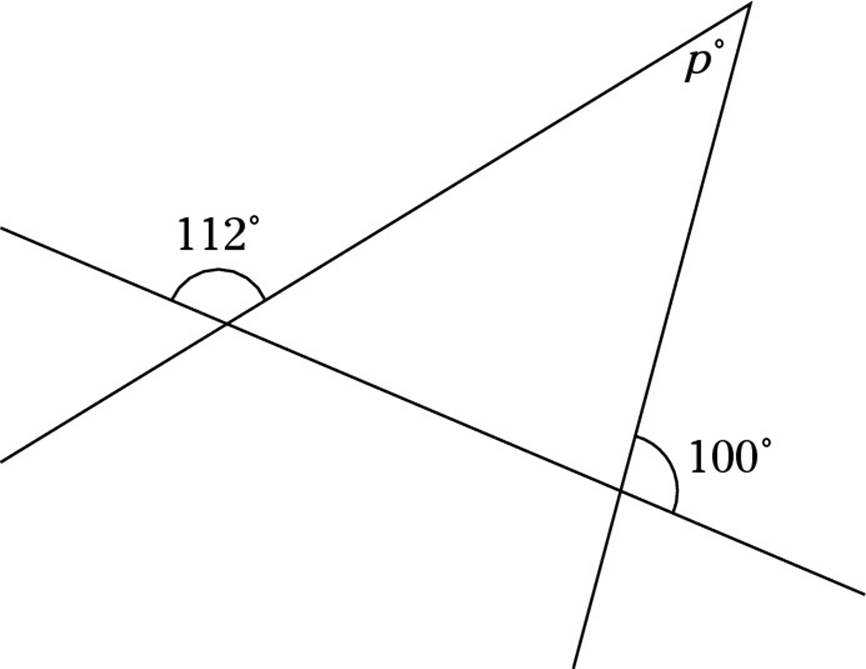
1. What is the value of p in the preceding figure?
(A) 32
(B) 68
(C) 80
(D) 122
(E) 148
Note: Questions 2 and 3 refer to the following chart, which represents the money that Sita has in her bank accounts during the years 2008, 2009, and 2010.
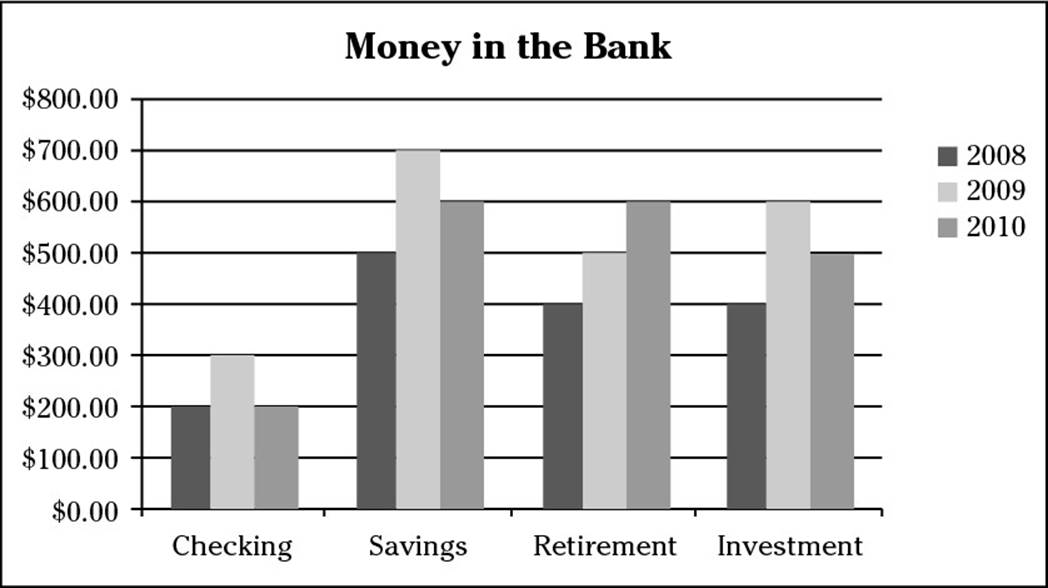
2. How much money does Sita have, in total, in all of her bank accounts in 2009?
(A) $1,500
(B) $2,000
(C) $2,100
(D) $2,200
(E) $2,300
3. If Sita’s money in her retirement account in 2008 represents 0.1% of the bank’s money, how much money is in the bank?
(A) $400
(B) $4,000
(C) $40,000
(D) $400,000
(E) $4,000,000
4. Which linear equation best models the following data?
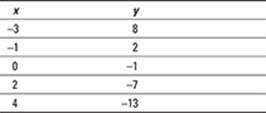
(A) ![]()
(B) ![]()
(C) y = –3x – 1
(D) y = 3x – 1
(E) y = 3x + 2
5. If f(x) = x2 – 3x + 1, then f(2x) = ?
(A) 2x2 – 3x + 1
(B) 2x2 – 6x + 2
(C) 4x2 – 3x + 1
(D) 4x2 – 6x + 1
(E) 2x3 – 6x2 + 2x
6. Given that the following statement is true, which statement is necessarily also true?
If Mary is at work, then Pierre is having lunch.
(A) Mary is at work.
(B) If Pierre is having lunch, then Mary is at work.
(C) If Mary is not at work, then Pierre is not having lunch.
(D) If Pierre is not having lunch, then Mary is at work.
(E) If Pierre is not having lunch, then Mary is not at work.
7. On the xy-coordinate plane, what is the area of the circle centered at (–2, 4) with a point on the circle at (1, 0)?
(A) 4π
(B) 9π
(C) 16π
(D) 25π
(E) 36π
8. Which of the following is true for all values of a and b?
I. ab ≤ |ab|
II. |a + b| = |a| + |b|
III. |a – b| = |b – a|
(A) I only
(B) III only
(C) I and III
(D) II and III
(E) none of the above
9. The arithmetic mean of four positive integers, a, b, c, and d, is 15. When the largest number is subtracted from the product of the smallest three numbers, the result is 34. If a < b < c < d, which of the following pairs of equations could correctly express the information given?
(A) a + b + c + d = 15
bcd – a = 34
(B) a + b + c + d = 15
abc – d = 34
(C) a + b + c + d = 30
abc – d = 34
(D) a + b + c + d = 60
bcd – a = 34
(E) a + b + c + d = 60
abc – d = 34
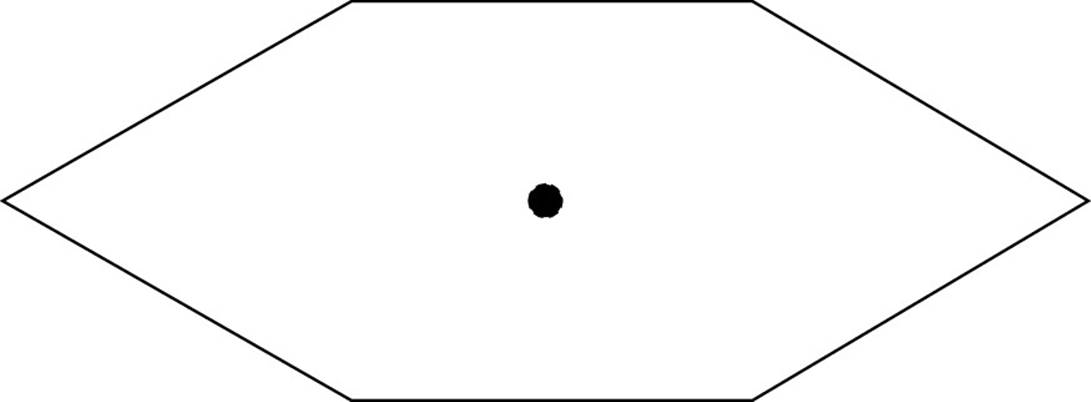
10. If this page were rotated 180° around the dot, the preceding image would match up with itself. Which of the following images, as shown, CANNOT be rotated 180° and match up with itself?
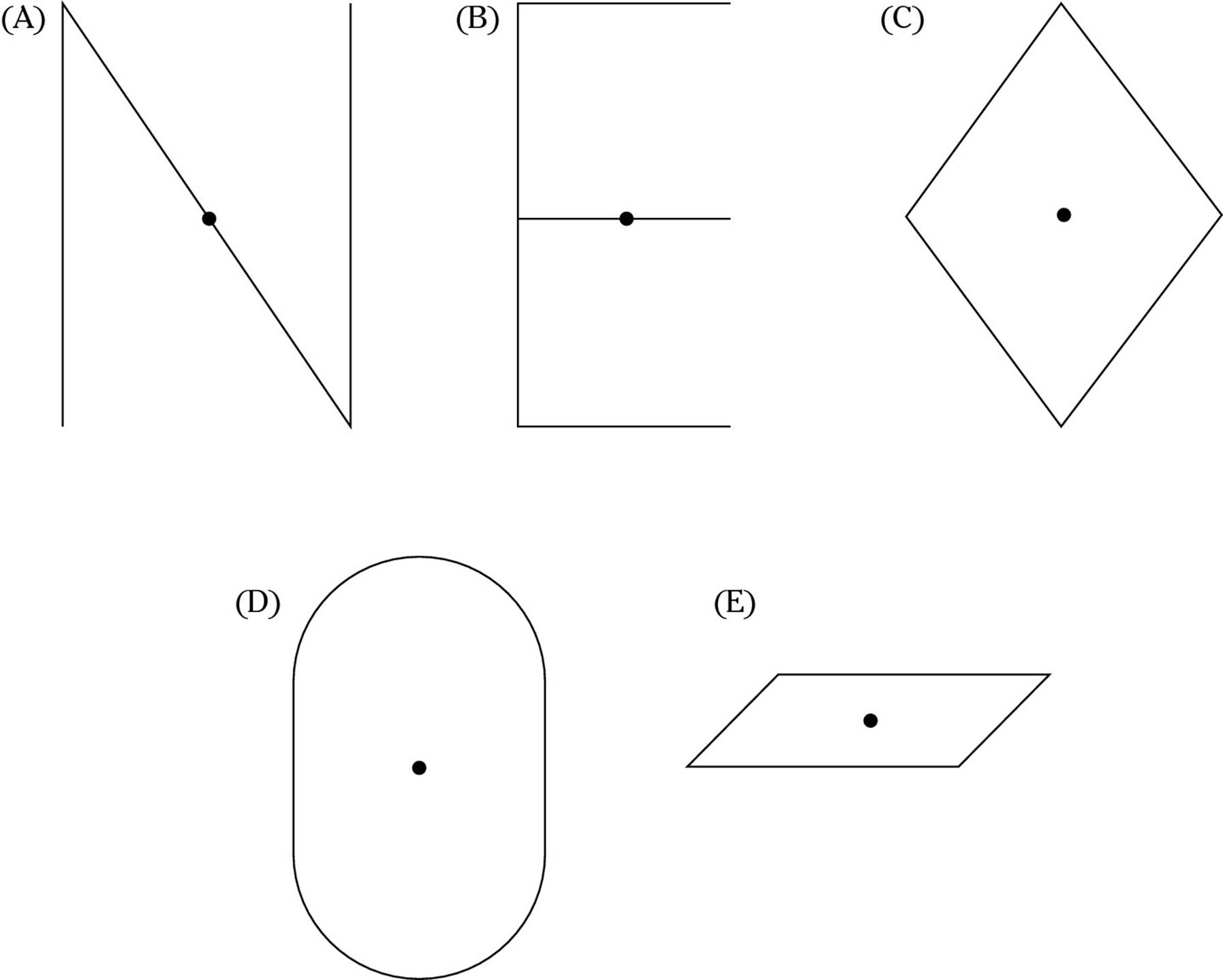
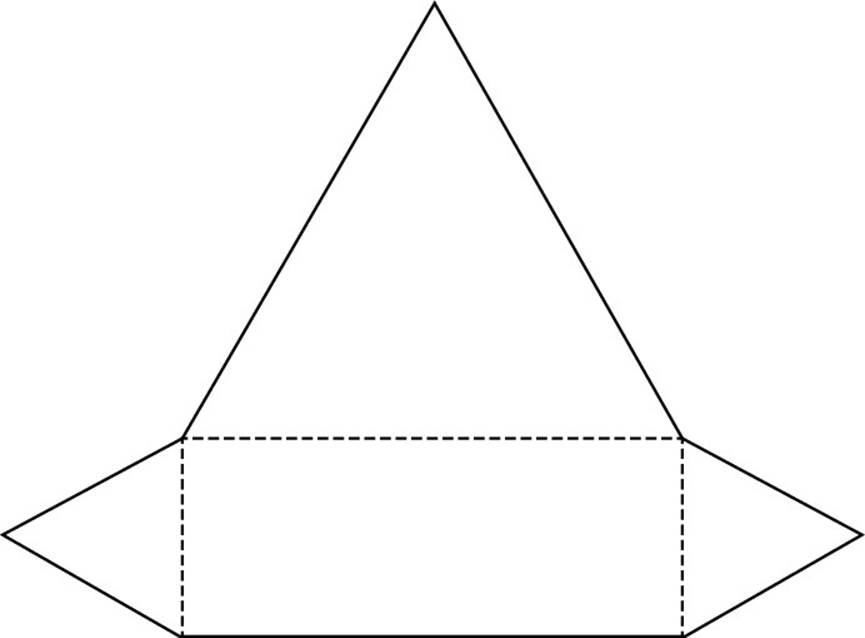
11. The preceding figure is constructed by appending equilateral triangles to three sides of a rectangle. If the rectangle is 6 inches long and 2 inches wide, what is the area of the figure, in square inches?
(A) 18
(B) ![]()
(C) ![]()
(D) 32
(E) ![]()
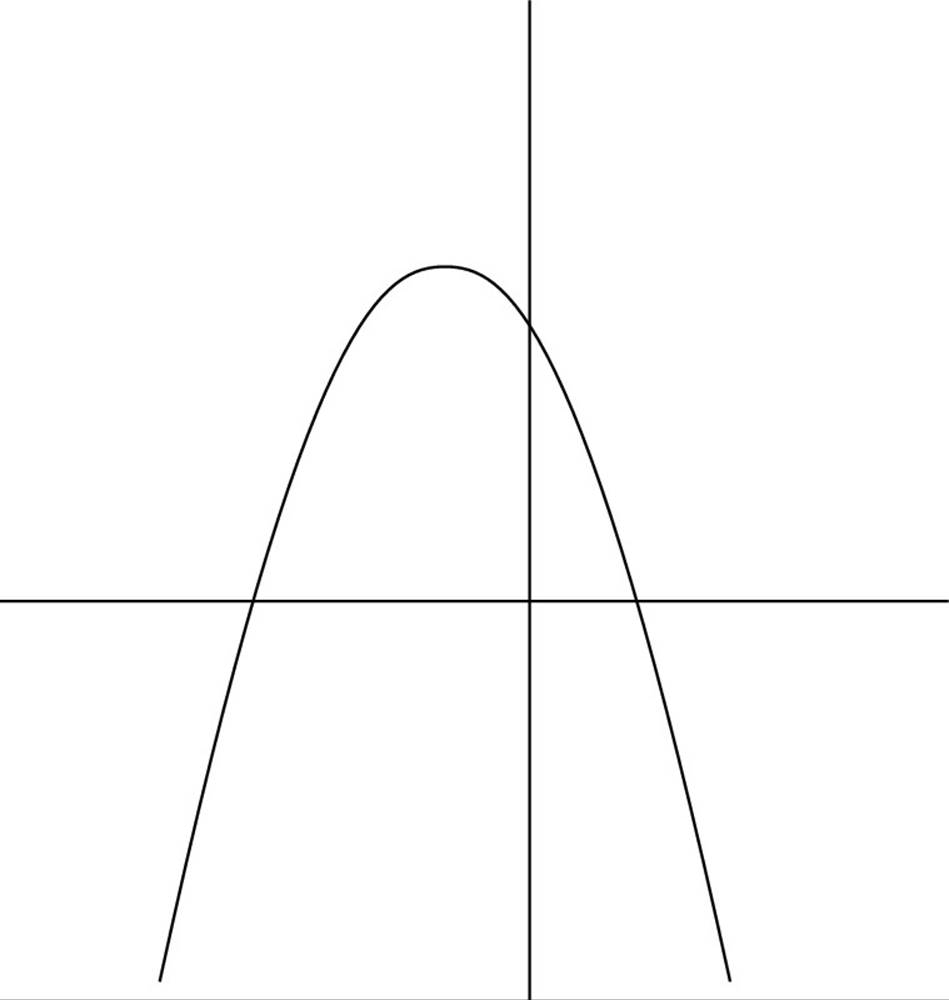
12. The graph shown here is of y = ax2 + bx + c. Which of the following is a true statement?
(A) a > 0 and c > 0
(B) a < 0 and c < 0
(C) a > 0 and c < 0
(D) a < 0 and c > 0
(E) a < 0 and c = 0
13. Anise has seven necklaces; two of them are identical. If she selects two necklaces without looking, what is the probability that she will select the identical necklaces?
(A) 1⁄49
(B) 1⁄42
(C) 2⁄49
(D) 1⁄21
(E) 1⁄7
14. A wheel with a diameter of 24 inches rolls along the ground. If it rotates 150 times, approximately how far will the wheel travel, in feet?
(A) 150π
(B) 240π
(C) 300π
(D) 360π
(E) 480π
15. A sequence begins 1⁄2, 2, 8, 32, . . . If 1⁄2 is the first term, 2 is the second term, and 8 is the third term, which of the following expressions represents the nth term?
(A) 1⁄2(2)n–1
(B) 1⁄2(4)n–1
(C) 1⁄2(4)n
(D) 2–n
(E) 4n
16. For any two real numbers p and q, define pGq as follows: pGq = p + q – 3. Which of the following equations are true?
I. pGq = qGp
II. 3Gq = q
III. (pGq)Gr = pG(qGr)
(A) I only
(B) I and II
(C) I and III
(D) I, II, and III
(E) none of the above

Section 9
Multiple-Choice Writing
Time: 10 minutes for 14 questions
Directions: Choose the best answer to each question. Mark the corresponding oval on the answer sheet. If the underlined portion of the sentence is best left alone, choose (A).
Example: Bert and him went to the store to buy boots in preparation for the approaching storm.
(A) Bert and him went
(B) Bert and he went
(C) Bert and he had gone
(D) Bert and him had gone
(E) Bert and himself went
The correct answer is Choice (B).
1. The musical is nevertheless blessed with an enthusiastic audience, which lasts for several hours.
(A) The musical is nevertheless blessed with an enthusiastic audience, which lasts for several hours.
(B) Having lasted for several hours, the musical is nevertheless blessed with an enthusiastic audience.
(C) Nevertheless, the musical is often blessed with an enthusiastic audience, which lasts for several hours.
(D) The musical, which lasts for several hours, is often blessed with an enthusiastic audience.
(E) The musical is nevertheless blessed with an enthusiastic audience, that lasts for several hours.
2. Most educators believe that before a student signs up for an elective course, you should check the requirements and subject matter.
(A) before a student signs up for an elective course, you should check
(B) before students sign up for an elective course, you should check
(C) before a student signs up for an elective course, he or she should check
(D) signing up for an elective course, you should check
(E) to sign up for an elective course, you should check
3. Last year’s senior representative having been admitted to a fine college, which was his favorite since he visited the campus while in elementary school.
(A) having been admitted to a fine college, which was his favorite
(B) was admitted to a fine college, which was his favorite
(C) being admitted to a fine college, which was his favorite
(D) having been admitted to a fine college that he favored
(E) admitted to a fine college, which was his favorite
4. Comics featuring superheroes often reflect current events; for example, one superhero was shown fighting the Nazis during World War II.
(A) current events; for example, one superhero was shown
(B) current events; such as one superhero was shown
(C) current events, and one superhero was shown
(D) current events like one superhero was shown
(E) current events, for example, one superhero showing
5. The Flatiron Building in New York City is shaped like a narrow triangle, it is a historic building that cannot be altered without permission from the Landmarks Preservation Committee.
(A) The Flatiron Building in New York City is shaped like a narrow triangle,
(B) The Flatiron Building in New York City, shaped like a narrow triangle,
(C) Shaped like a narrow triangle, the Flatiron Building in New York City,
(D) The Flatiron Building in New York City is shaped like a narrow triangle, subsequently
(E) The Flatiron Building in New York City is shaped like a narrow triangle, and
6. There have been important court decisions that alter society, and the course of history, so the legal system plays a major role in the life of every citizen.
(A) that alter society, and the course of history,
(B) which, while they alter society, and the course of history,
(C) alter society and the course of history,
(D) that alter society and change history,
(E) that, while altering society, they change the course of history,
7. If I would have known about the low level of ink in the printer, I would have purchased a new supply.
(A) If I would have known about
(B) If I were to have known about
(C) Would I have known about
(D) If I had been in the know about
(E) If I had known about
8. Encouraged by her father to become an artist, many portraits of the Spanish royal family were painted by Sofonisba Anguissola in the 16th century, when nearly all professional artists were male.
(A) many portraits of the Spanish royal family were painted by Sofonisba Anguissola
(B) Sofonisba Anguissola painted many portraits of the Spanish royal family
(C) Sofonisba Anguissola had painted many portraits of the Spanish royal family
(D) many portraits of the Spanish royal family, they were painted by Sofonisba Anguissola
(E) many portraits of the Spanish royal family Sofonisba Anguissola painted
9. A psychological experiment determined an important fact about music, and it was learned that pauses in the flow of sound capture the listener’s attention most strongly.
(A) about music, and it was learned that pauses
(B) about music, pauses
(C) about music, that pauses
(D) about music, where it was learned that pauses
(E) about music, being that pauses
10. The island nation of Tuvalu, which occupies nine islands in the South Pacific, and they have little land for farming and few industries, earns a significant amount of money licensing its web address, “TV.”
(A) which occupies nine islands in the South Pacific, and they have little
(B) which occupying nine islands in the South Pacific, and it has little
(C) which occupies nine islands in the South Pacific and has
(D) occupying nine islands in the South Pacific, having
(E) which occupies nine islands in the South Pacific, and it’s got little land for farming and few industries,
11. The “Black Sox” baseball scandal of 1919 discovered that some players received money from gangsters, and so they were punished.
(A) received money from gangsters, and so they were punished
(B) receiving money from gangsters, they were punished
(C) were paid by gangsters, who punished
(D) paid by gangsters, and who were punished
(E) received money from gangsters and were punished
12. Biology, which is the study of all living things, is more difficult to learn than any subject.
(A) is more difficult to learn than any subject
(B) is more difficult to learn than any other subject
(C) is found by students to be more difficult to learn than any subject
(D) most students find more difficult to learn than any other subject
(E) makes learning it more difficult than other subjects
13. When Ellen changed jobs, she had to decide what it was she should do about her health insurance.
(A) what it was she should do
(B) what she should be doing
(C) her actions regarding what she should do
(D) what she should do
(E) how she should, with respect to health insurance, do
14. In the grocery store on 12th Street, melons and peaches are prominently featured in a display near the front door.
(A) In the grocery store on 12th Street,
(B) On 12th Street, it is in a grocery store that
(C) Going into a grocery store on 12th Street,
(D) It is in a grocery store on 12th Street that
(E) In the grocery that is located on 12th Street,
